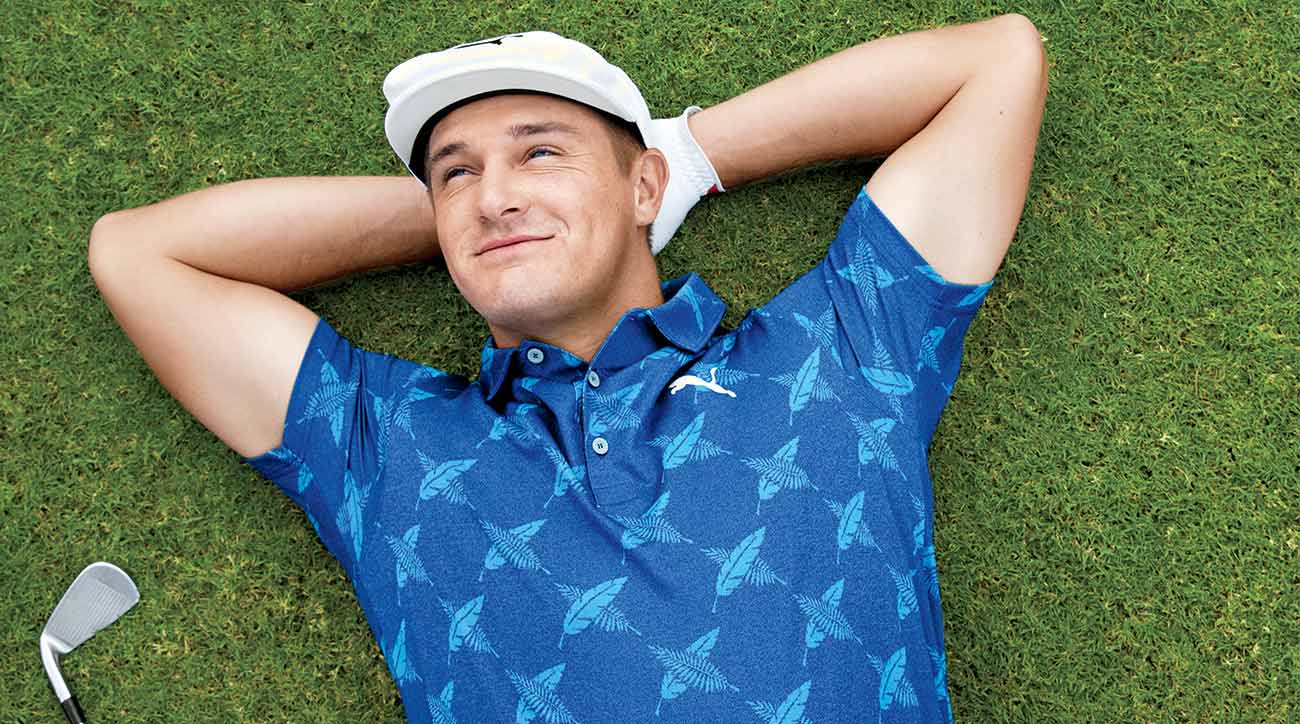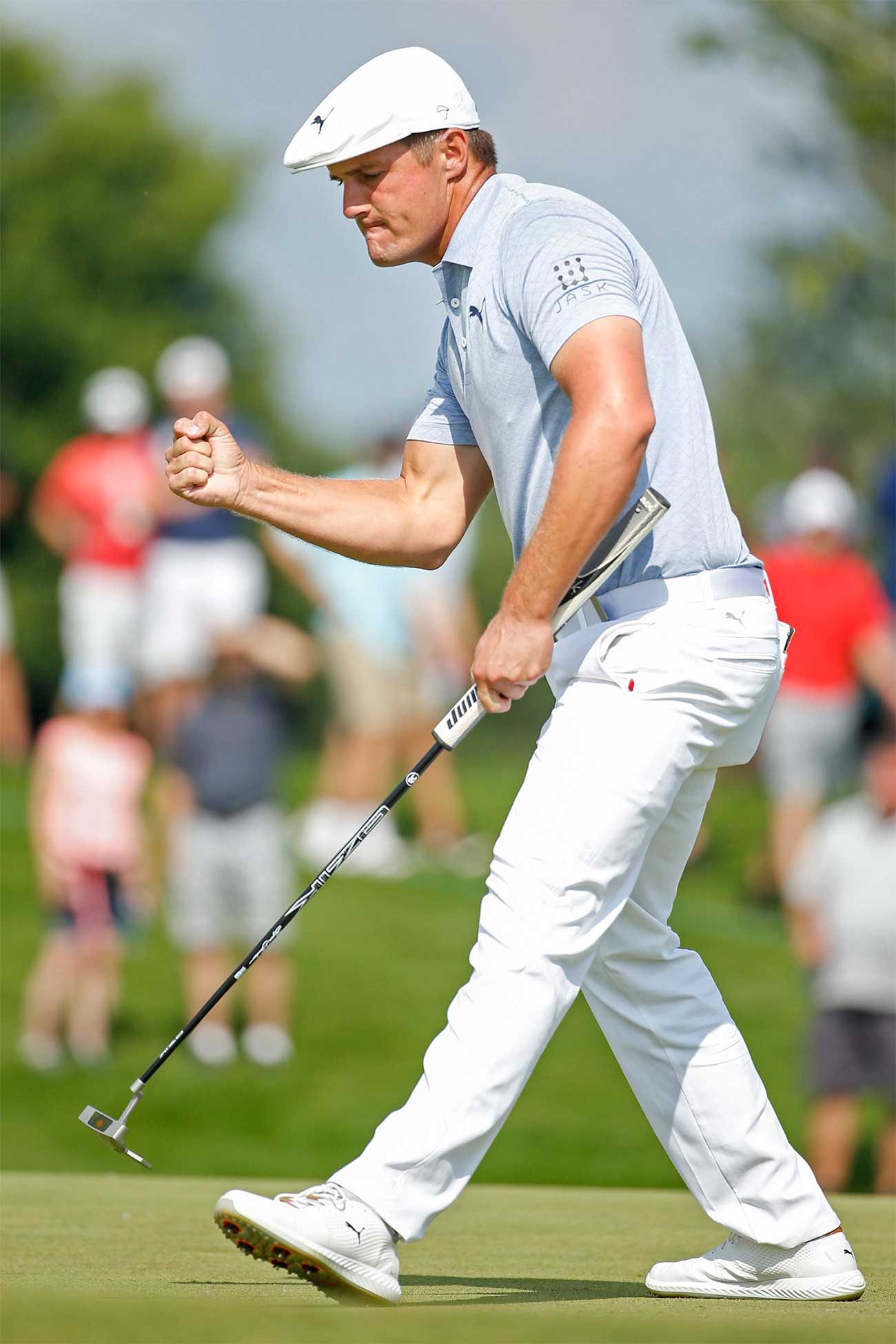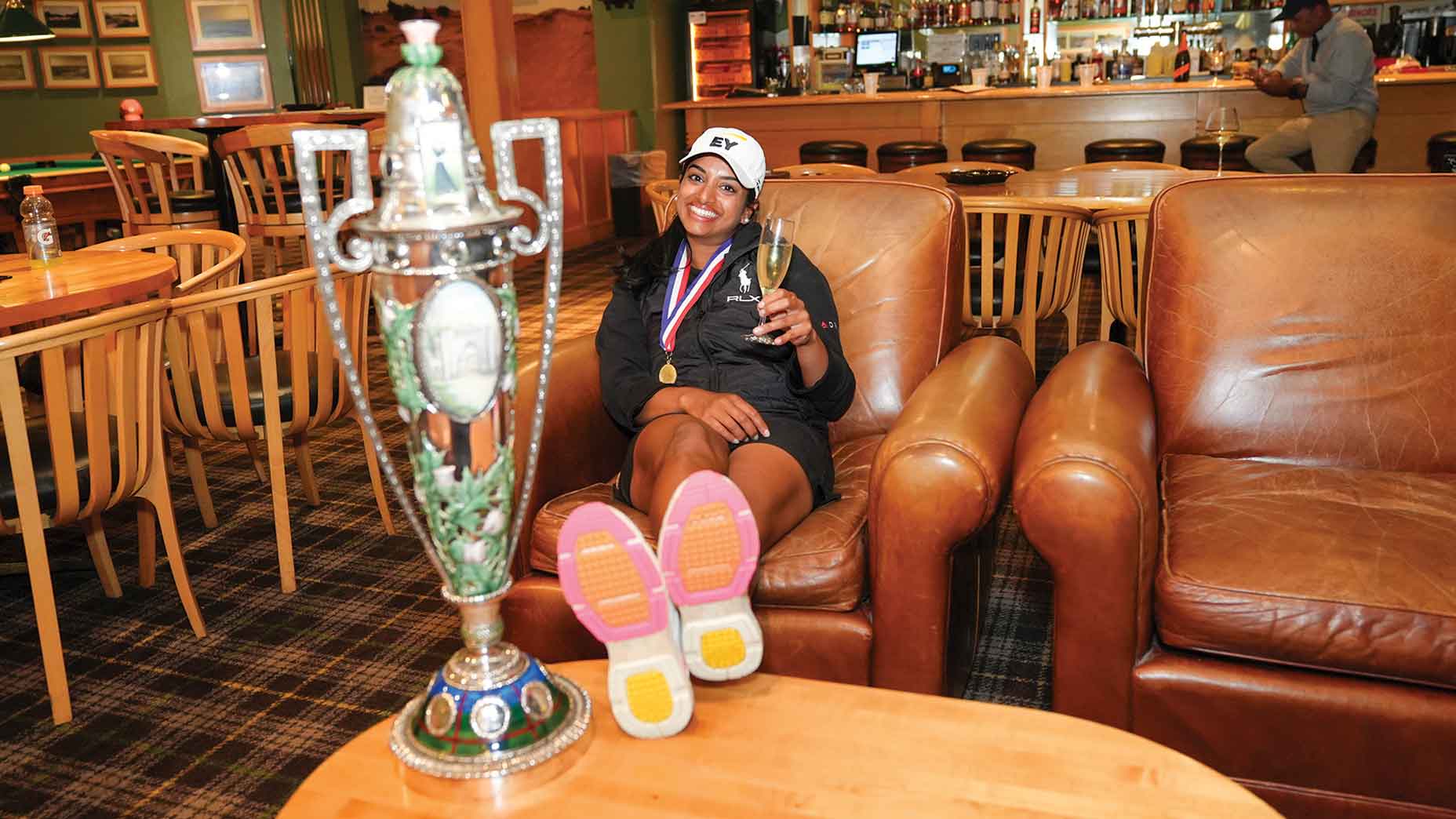 A brief history of golf’s most fundamental words: par, birdie, caddie and more
A brief history of golf’s most fundamental words: par, birdie, caddie and more
Bryson DeChambeau dreams of the perfect game (and will do anything to get there)
There is a stirring at the driving range: Bryson DeChambeau has arrived. The postures of the Cobra engineers stiffen. A Flightscope technician fiddles with the dials on his launch monitor, suddenly looking busy. The JumboMax guy lays out a row of new prototype grips. A Bridgestone rep readies the latest batch of balls tweaked to DeChambeau’s specifications. Finally, Bryson’s caddie trudges over with an ungodly number of extra clubs stuffed into the bag. His boss sprinkles bonhomie as he works the range, joshing with a few players and then busting the chops of his assembled team. The practice tee is both a laboratory and a playground for DeChambeau, 25. It’s where he digs secrets out of the dirt while crunching terabytes of data in his beautiful mind. It is where he feels most at home.
Today, in late March, at the Match Play Championship, in Austin, Texas, seven people have assembled around DeChambeau, and this is just another day at the office; variations of this scene are repeated during practice sessions every time he shows up at a tournament. It is the most unwieldy entourage on Tour, subject to side-eye from colleagues and snarky comments on Twitter. But to Bryson, this collection of thinkers and tinkerers are an indispensable part of his success, and they all share a common vision. “He’s on an endless quest,” says Ben Schomin, the director of Tour operations for Cobra Puma, “and he knows he can’t get there alone. We’re here to help him and to challenge him and sometimes talk him off the ledge. It’s a symbiotic relationship. Are there times when he drives us crazy? Maybe. But we learn as much from Bryson as he does from us.”
Every member of the team has a role to play, and they are interconnected. On the eve of the Match Play, DeChambeau grinded deep into the twilight, testing new grips, new shafts and a dozen different wedge configurations. The only break in the action came when he pulled out his phone and cued up favorite clips from Anchorman, just to lighten the mood. Once, twice, three times his caddie Tim Tucker made the lonely walk to retrieve more bags of practice balls. By the time darkness fell, DeChambeau had decided to change grips, going from a beefy model of 121 grams down to 53. (All the monkeying around with DeChambeau has led JumboMax to create a new mass-market grip-fitting system, which will allow everyday players to find the optimum grip weight for their idiosyncratic swings. (“This is going to be as big a deal as when woods went from persimmon to metal,” says John Mazzanoble, the excitable company president.) The much lighter grips affected the way DeChambeau’s shaft kicked, necessitating intervention from Schomin’s team: They swapped out his True Temper x7s, which are about as stiff as a telephone pole, for softer S400s. Searching for the perfect feel with his new sticks, Bryson began tweaking the pronation in his wrist, which would require input from his swing coach Chris Como. During all of the related testing, every swing was recorded by Flightscope, which, at DeChambeau’s urging, has incorporated hourly weather data so it can be quantified how changes in humidity and barometric pressure, among other things, affect the flight of the ball.

Wasn’t this a lot to take on just a few weeks before the biggest tournament of the year?
“I’m not worried about the Masters,” DeChambeau said with some heat. “I never worry about this tournament or that tournament. I don’t care if I have to take a whole year to get this right. What matters to me is the process, not the results.”
Underpinning all of this experimentation is DeChambeau’s obsession with improving his wedge play, the only bugaboo in a game that carried him to four PGA Tour victories in 2018. “If I can figure out this wedge stuff and become a really good wedger, I’ll be the number-one player in the world,” DeChambeau says. This kind of brash pronouncement has led to blowback in the past. Bryson remains as cocksure as ever, but at least now he is more self-aware: No sooner had these words been uttered than he punched a reporter on the arm and said, “That’s some good material for you, huh?”
DeChambeau’s quest can be easy to spoof until you’re confronted with how much sense it all makes. At last year’s Shark Shootout, Kevin Na paired with Bryson and was mystified by some of the practice-round preparation. Then he witnessed how adroitly his partner putted from off the green. “I’m giving away one of Bryson’s secrets, but he Stimps the fairway cut near the green and also the fringe,” says Na in a conspiratorial whisper. “You know how when you have that putt from off the green, it’s always a guess as to how the ball will roll out through the different grasses? Well, it’s not a guess for him, because he knows it down to the foot.”
There has been much clucking about paparazzi-style videos of DeChambeau spritzing water onto practice balls. What’s the point — everyone knows that water on the clubface will reduce the amount of spin, right? Actually, through extensive testing DeChambeau has found that to be true for lofted clubs, but with his long irons he actually generates more spin — up to 1,000 RPM. In July of this year, when the Tour visited Minneapolis, DeChambeau sought out 3M scientists who postulated that with less-lofted clubs the water molecules get trapped on the face at the moment of impact and create extra friction, which imparts more spin. This seems like esoterica until you face a do-or-die 4-iron on a foggy day at Pebble Beach or a drizzly day at Royal Portrush.
DeChambeau has such certainty in the metronomic consistency of his swing that when a shot goes awry he instinctively looks for an outside agency. He plays many practice rounds with Tiger Woods, a fellow golf nerd always seeking an edge. During a tuneup round this year at Riviera, DeChambeau crunched all the numbers on the tee of the par-3 14th hole and then flushed a 7-iron that came up a full club short. Woods, who made his Tour debut on the course more a quarter century ago, smoothed a 6-iron to pin-high. He then explained to DeChambeau that because Riviera sits at the bottom of a canyon near the Pacific, the air somehow plays heavier than other sea-level courses. DeChambeau is the only guy on Tour who records every practice-round shot on a launch monitor. “With Bryson, there are a lot of firsts,” says Schomin. Hearing Woods’s analysis, DeChambeau turned to Flightscope founder Henri Johnson, who was lugging around the machine that day, and insisted they build a new model that could account for differences in air density and other atmospheric factors. Thus the new X3 model was born, and the proprietary information is so enlightening that one of DeChambeau’s pals immediately spent his own money to obtain one: Bubba Watson, a celebrated caveman golfer who under the thrall of Bryson has suddenly become more intellectually curious.
ADVERTISEMENT
Now, before every competitive swing, DeChambeau and his caddie run through a protocol to estimate the air temperature, barometric pressure, temperature of the ball, moisture level of the ground, the firmness of the green, the slope of the lie and the angle of descent of the ball based on the shot shape they’re considering. (No wonder DeChambeau has been at the center of the recent firestorm over slow play. He has always insisted he speed-walks to his ball, allowing him to take more time to mull over the shot, but he recently put out a conciliatory statement saying he would make efforts to speed up his play.) And yet all of this data is not enough for DeChambeau. The other day he woke Johnson with a call, asking if he could theorize how far his sand wedge would fly for every minute of a prototypical day, based on a model of ever-changing air conditions. Johnson, who has a Masters degree in electrical engineering and has designed sonar defense systems in his native South Africa, crunched all the data and sent DeChambeau a mathematical formula. He spent the ensuing days hitting his wedge more or less around the clock and then called Johnson to let him know the numbers checked out. “He’s a very unusual character,” Johnson says, redundantly. “He has a level of focus — some might call it obsession — that you can’t compare to any other golfer. Maybe not any other athlete, except the climber in Free Solo.”
DeChambeau has heard all the nutty-professor jokes — and has even incorporated them into various TV commercials — but he insists it is not shtick. “It’s funny, I hear people say I’m faking all this science stuff. That’s the furthest thing from the truth,” he says. “It’s literally what I have to do to play and perform at this level. I have so much respect for all these other guys who are able to play at a high level, week in and week out, without all this information. That doesn’t work for me. The search for information gives me more confidence, because confidence arises from understanding. If people knew the whole journey, the struggles I’ve been through to figure out all this stuff, I think they would gain a little bit more respect for me, rather than disdain.”
DeChambeau is so used to being an outsider he doesn’t realize that the respect is already there. “He’s a breath of fresh air,” says Pat Perez, a quintessential feel player. “It’s good for the game because he’s showing there is room for all kinds of players to succeed. He knows what works for him, and he doesn’t give a f— what anybody thinks. He’s proved everybody wrong, and I think that’s awesome.”
Max Homa puts it another way: “You can’t science your way to a trophy — you still have to play the game. He’s obviously very good at that, which is maybe what people should focus on a little more.”
But for DeChambeau, the science keys his ability to separate himself from the competition. “Everybody is practicing hard, you can’t gain an advantage there,” he says. “It’s not about producing more speed and power — that’s figured out. It’s a question of how can I repeat motion at a higher percentage? How can my range of outcomes be tighter than anyone else’s? These are the big questions. Rome wasn’t built in a day. I’m not saying I’m building Rome, but we’re trying to figure out stuff that hasn’t been figured out yet. Repeatability is the next frontier. It’s just a question of who figures it out first.”

And this brings us back to DeChambeau’s quest to dial in his wedges, what he calls “the most maddening thing ever.” In some ways it is simple physics. In his groundbreaking set of single-length irons, DeChambeau’s wedges are 2 1/4 inches longer than standard. The heads are lighter but not enough to counterbalance DeChambeau’s speed: He swings his lob wedge at up to 95 miles per hour, whereas most Tour players rarely touch 80. He produces so much spin (up to 13,000 RPM) that every now and then the ball will crawl up the face of the club and fly unpredictably. (In 2018, DeChambeau was 12th in Strokes Gained off the tee and fifth in proximity on approaches from more than 200 yards, but a pedestrian 80th on shots from 50-125 yards.)
All the changes to his gear that came out of the Match Play did not solve the problem: DeChambeau was a non-factor at the Masters, then followed that with three straight missed cuts, the worst funk since his breakthrough win in 2017 as a sophomore on Tour. It is a sign of his desperation that at various points this year Bryson has experimented with standard-length wedges. “At Bay Hill, he took Steve Sticker’s wedges and was hitting them better than Stricker was,” says Johnson. But DeChambeau is such a believer in single-length, and it is so fundamental to his identity, that he never seriously considered making the switch. Instead, he tried every other setup tweak imaginable, including pushing Bridgestone to invent for him a brand new ball. (It’s a concept that DeChambeau calls “so proprietary I can’t discuss it.”)
At the 3M Open, in July, the driving range was packed with DeChambeau acolytes. They had honed in on groove design as a possible fix, and so Bryson was testing a variety of different makes and models. (Each had a 37.5-inch shaft, like all of DeChambeau’s irons.) He found a set of PXGs with less aggressive grooves that produced basically the exact same amount of spin with every swing. Incredulous, DeChambeau hit ball after ball, and the numbers on the launch monitor kept coming up aces. The PXGs were in the bag for his opening-round 66, after which he said, “The wedges were flawless. I hit one on 10 today that was one of the best shots I’ve ever hit.” The next day he shot a career-low 62 to roar into the lead. In the final round, DeChambeau was part of a thrilling dogfight with phenom Matt Wolff, but despite a 72nd-hole eagle he came up one shot short. Still, DeChambeau was flying high on the way out of Minneapolis. “That’s one big piece of the puzzle we’ve figured out, or are closer to figuring out,” he said. Loyal company man that he is, Bryson is eager to get Cobra wedges back in his bag, so at press time a set was being built with grooves identical to the PXGs.
The near-miss in Minneapolis pushed DeChambeau to sixth in the World Ranking. Only five more spots to go.
Bryson’s revelation with his wedges calls to mind Hans Gruber’s monologue in Die Hard, about Alexander the Great weeping when he discovered there were no more worlds left to conquer. Does DeChambeau ever fret that someday he will figure out all of golf’s secrets, putting an abrupt end to the quest that defines him? “No, no, no, no, no, I would love that!” he says. “I’d be out there hitting every shot perfect, just smilin’ at everybody, goin’, ‘Ha, I have all the answers.'”
DeChambeau had a big grin picturing this in his mind, but it quickly dissolved. “Actually,” he said, “that would be cool for a little while, but then it would get boring.”
ADVERTISEMENT





